Payoff Matrices
Payoff matrices can help us analyze the behavioral strategies and possible outcomes in diverse situations across biology and society.
Many situations in our everyday experience are social interactions – our behaviors not only have effects on ourselves but on others around us, and likewise, other people’s behavior has not just effects on them but also on us. This is because we humans live in social groups and in a world that is constantly being changed and created by other humans.
Evolutionary biologists, behavioral scientists, and sustainability scientists sometimes represent the costs and benefits that people (or other living beings) get from a behavior in such social interactions through a so-called payoff matrix.
Payoff matrices help to identify whether there is a social interaction between individuals. This helps us understand the level or size of group we need to look at in order tounderstand the causes and outcomes of behaviors in a social-ecological system.
Do outcomes for me change depending on how other people behave? And/or are outcomes for others influenced by how I behave? Then we are talking about social interactions.
If I or my community prefer certain outcomes, I will have to engage those individuals who interact with me, so that we can all agree to behave in a way that is best for all of us.
But this requires that we all agree on what the preferred outcomes should be!
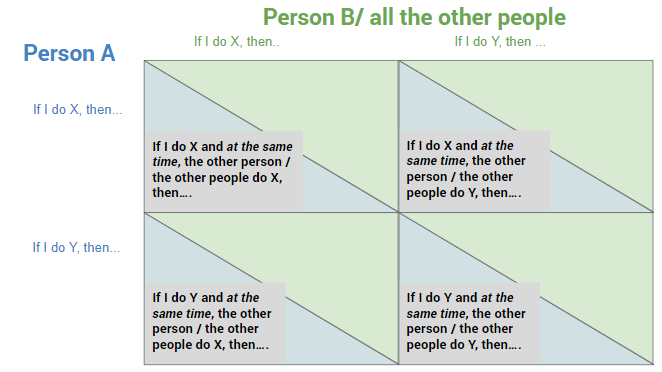
Using payoff matrices in the classroom helps us reflect on the possible causes and consequences of behaviors in particular situations.
Essential questions that the payoff matrix helps explore:
What motivates humans to behave in a certain way in a particular context, and what outcomes does this behavior create? What role do context and history, beliefs, constraints, goals and preferences play?
Are consequences of a behavior in this situation influenced by what other individuals do? (social interactions)
Can benefits and other consequences of a behavior be different between the short-term and the long-term?
Some ways that teachers might adapt and extend the use of payoff matrices as reflection and discussion tools in the classroom:
Create fictional characters with certain background information (e.g. on note cards) whose perspective students take as they fill out a payoff matrix (How could this person behave in this situation, and why?)
Have students play out people’s possible behaviors in a situation in a role play
Payoff matrices also help to identify whether there is a social dilemma between what individuals are motivated to do in the short-term and what is best for the community in the long-term.
Social dilemmas seem to be at the heart of sustainability challenges. Sustainability scientists explore how we can solve such dilemmas by finding ways to align the interests of individuals with the interests of the whole group.

Traffic jam as a social dilemma.
Image source: https://getmeoffthisplanet.files.wordpress.com/2008/10/trafficjam.jpg?w=620
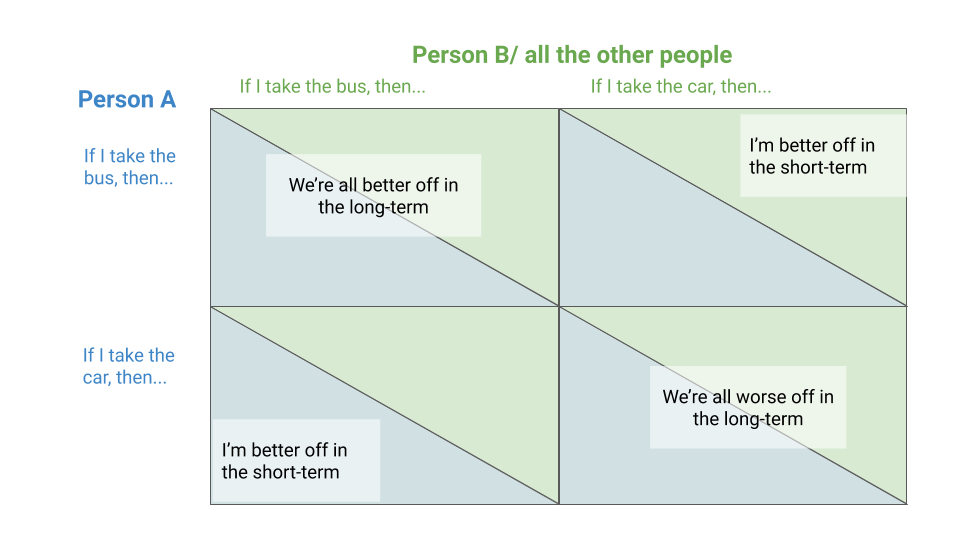
Are benefits and other consequences of a behavior different between the short-term and the long-term?
If yes, how can we assure that the short-term motivations for certain behaviors are aligned with long-term goals?
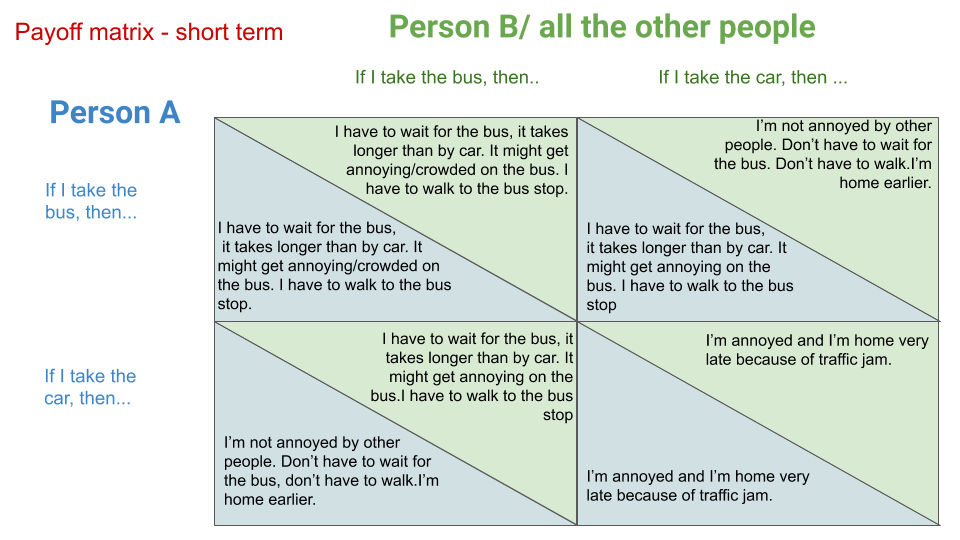
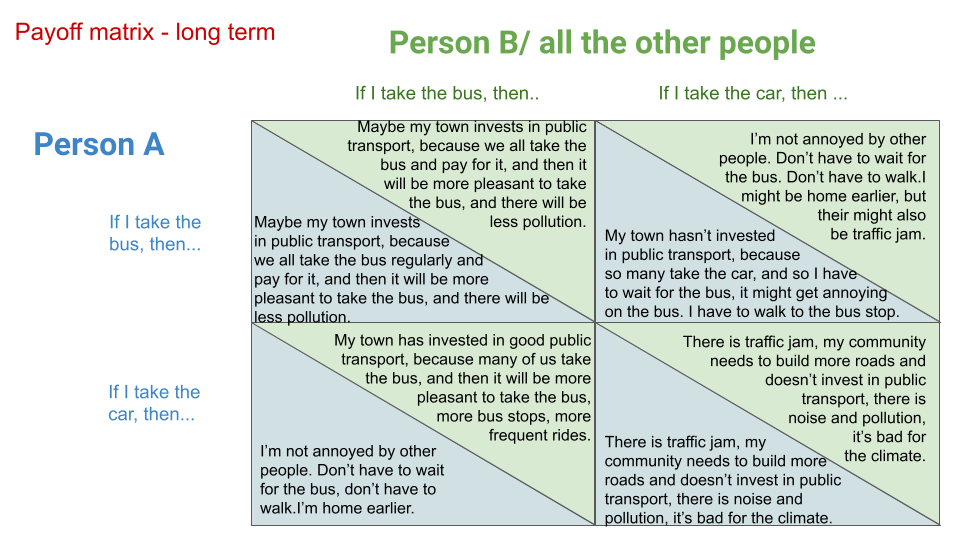
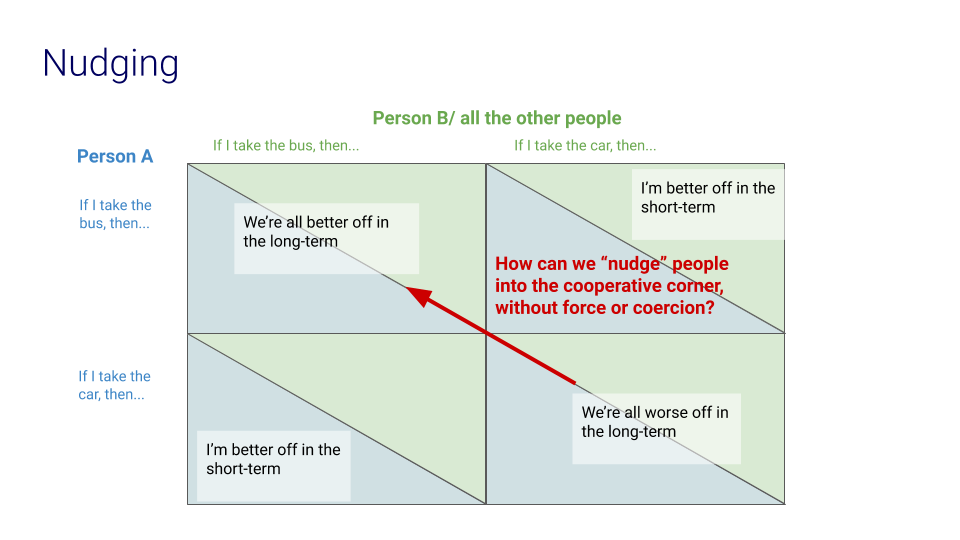
Teaching Materials that use the Payoff Matrix
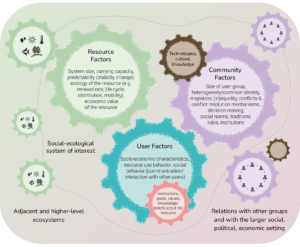
Analyzing social-ecological systems
In this lesson, students analyze a select real-world social-ecological system by looking at factors of the resource(s) and ecosystem, resource user behaviors, and governance, to develop recommendations for improving the sustainable management of the resource.

Climate Change Game
A cooperation game that lets students experience some of the challenges of cooperation in addressing global climate change

Collective Action Puzzle Game
A group game that lets students experience the dilemma between self-interest and collective interest when groups have to work together to achieve shared goals.

Commons game
In a classroom simulation game with changing conditions students develop strategies for the use of a common resource so that the profit for the entire group is maximized.

Game theory: Ultimatum and Dictator game
A set of behavioral experiments across cultures that explore the human sense of fairness.

Introduction to social dilemmas and the payoff matrix
Students reflect on the causes and consequences of human behaviors in situations of social interactions, and are introduced to the payoff matrix as a helpful tool to represent motivations and outcomes of behaviors.

Lost wallet study
A behavioral experiment across 40 countries that explored human motivations to return lost wallets to their owner

NetLogo: Evolution of ethnocentrism
This model simulates the biological evolution of ethnocentrism in a population made up of multiple ethnicities.

NetLogo: Evolution of resource use and social behavior (monitoring and punishment)
This model lets us explore how the appearance of certain social behaviors can affect evolutionary population dynamics.

NetLogo: Two Foresters
An interactive introduction into concepts of ecology, behavioral ecology, and sustainability with a computer simulation of a simple social-ecological system.

